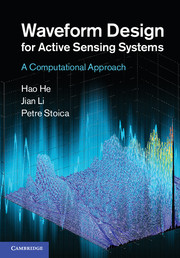Book contents
- Frontmatter
- Contents
- Preface
- Notation
- Abbreviations
- 1 Introduction
- Part I Aperiodic correlation synthesis
- Part II Periodic correlation synthesis
- Part III Transmit beampattern synthesis
- 13 Narrowband beampattern to covariance matrix
- 14 Covariance matrix to waveform
- 15 Wideband transmit beampattern synthesis
- Part IV Diverse application examples
- References
- Index
13 - Narrowband beampattern to covariance matrix
from Part III - Transmit beampattern synthesis
Published online by Cambridge University Press: 05 August 2012
- Frontmatter
- Contents
- Preface
- Notation
- Abbreviations
- 1 Introduction
- Part I Aperiodic correlation synthesis
- Part II Periodic correlation synthesis
- Part III Transmit beampattern synthesis
- 13 Narrowband beampattern to covariance matrix
- 14 Covariance matrix to waveform
- 15 Wideband transmit beampattern synthesis
- Part IV Diverse application examples
- References
- Index
Summary
Antenna array beampattern design has been a well-studied topic and there is a considerable literature available from classic analytical design [Mailloux 1982][Dolph 1946][Elliott 1975][Ward et al. 1996][Van Trees 2002] to more recent works that resort to numerical optimization [Lebret & Boyd 1997][Scholnik & Coleman 2000][Cardone et al. 2002][San Antonio & Fuhrmann 2005][Li, Xie, Stoica, Zheng & Ward 2007]. The predominant problem considered in the literature refers to the receive beampattern design, which is concerned with designing weights for the received signal so that the signal component impinging from a particular direction is reinforced while those from other directions are attenuated, a way in which certain signal properties (e.g., the signal power or direction-of-arrival) can be estimated. Such a problem usually boils down to the design of an FIR (finite-impulse-response) filter in the narrowband case or a set of FIR filters in the wideband case.
The transmit beampattern design, on the other hand, is concerned with designing the probing signals to approximate a desired transmit beampattern (i.e., an energy distribution in space and frequency). It has been often stated that the receive and transmit beampattern designs are essentially equivalent, which is partly true in the sense that the two scenarios bear similar problem formulations and that the FIR filter taps obtained via receive pattern design can be used theoretically as the probing signal to achieve an identical transmit pattern. In practice, however, the transmit beampattern design problem appears to be much harder because of the energy and peak-to-average power ratio (PAR) constraints on the transmit waveforms.
- Type
- Chapter
- Information
- Waveform Design for Active Sensing SystemsA Computational Approach, pp. 187 - 212Publisher: Cambridge University PressPrint publication year: 2012



